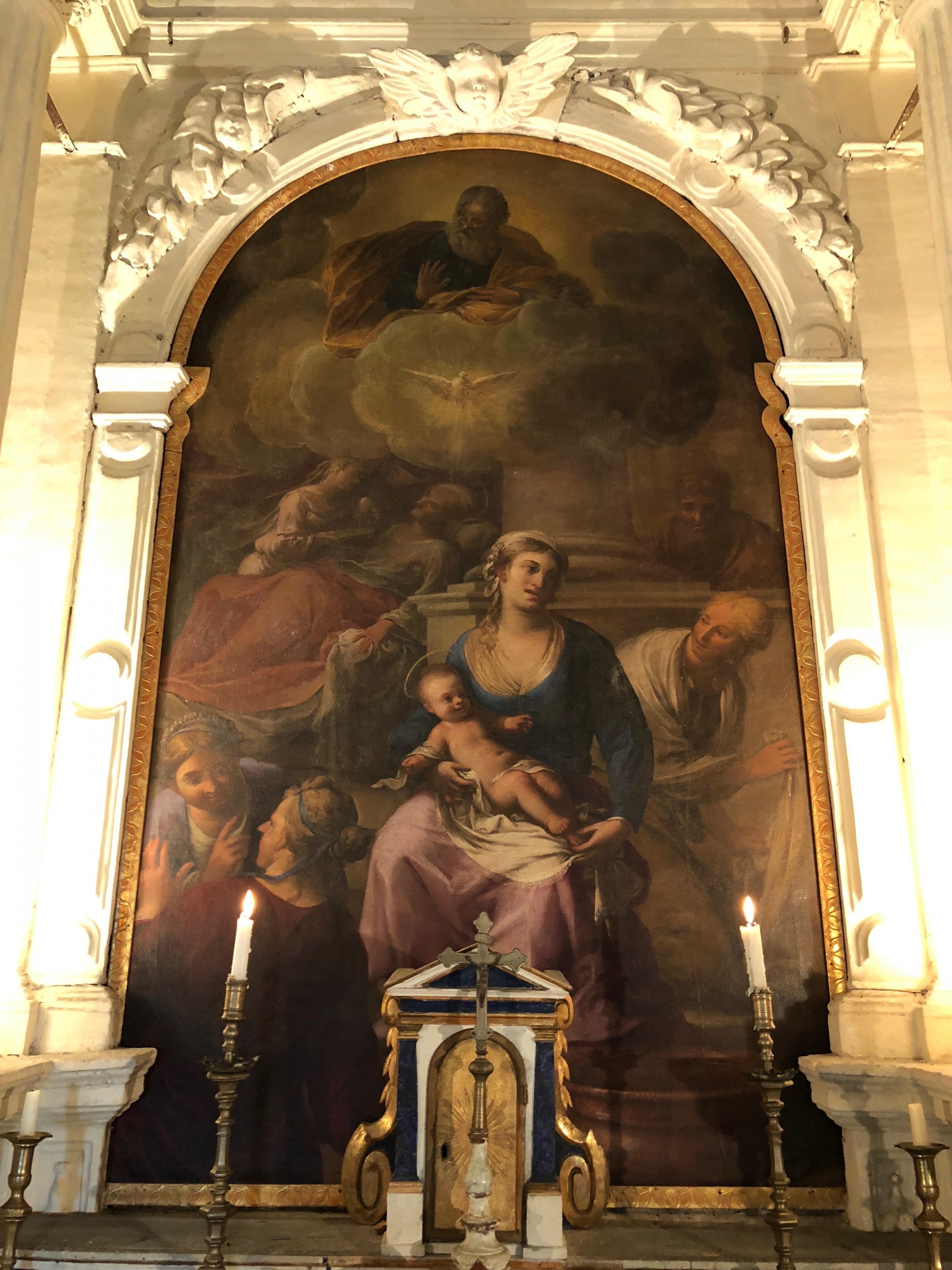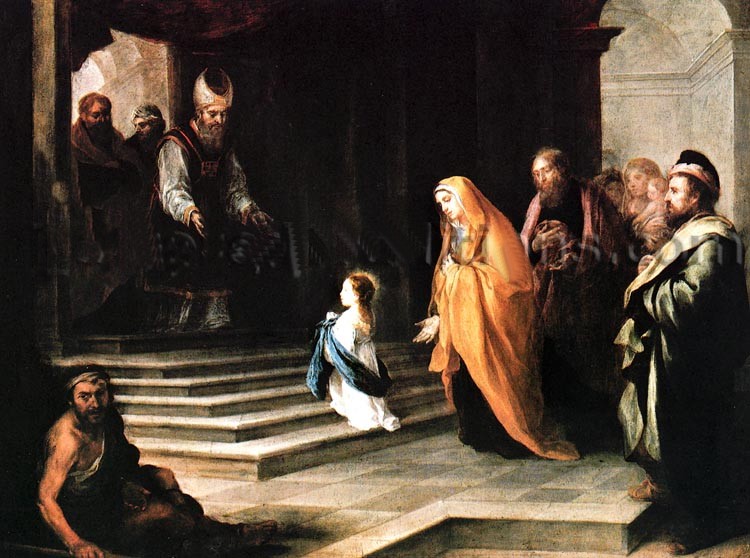“I Will Bring Mary as a Gift to the Lord My God”
Mary, indeed, served in the Temple until she was a young woman.

If you’ve taken a keen eye to sacred art, you might realize that, while there is generally consistency from artist to artist on biblical and saintly scenes, an untrained eye might have difficulty identifying the particulars in extra-biblical scenes. Take for example the Nativity of Mary:

This is an original, from a Villa Chapel I visit frequently near Padua. The first time I saw it, honestly, I assumed it was perhaps the nativity of . . . Jesus . . . or John the Baptist? Or perhaps even some post-manger scene for Jesus? Now, context clues are put to use. In the Nativity of Christ there are almost always a shepherd, an angel, a star, a bed of straw, or some combination of these. It was only after my priest told me that what I was looking at is the Nativity of Mary that it made sense. Perhaps it was obvious to him when he first saw it, but there was the “aha!” moment when he told me what I was looking at.
Likewise, you might have noticed something unusual about today’s feast, the Presentation of the Blessed Virgin Mary. Maybe you’ve seen an image similar to this one:

Obviously it is one of those milestone scenes: something important at the temple is happening here, but did you immediately know that the little girl was the Blessed Virgin? Really, the Bible contains such little information about Mary, it would be impossible from a biblical perspective alone to know what this picture is relaying. As such, today we celebrate the Presentation, but why does Mary appear to be a little girl, or in some depictions, almost a young woman? When we think of presentations at the temple, we might be justified to immediately imagine an infant. The narrative in Luke 2 tells us of Jesus’s presentation at the temple in the verses immediately after his circumcision (2:21-24) in accordance with Exodus 13, as an infant. Well, if today is the presentation, and Jesus was presented at the temple as an infant, why was Mary presented as a child perhaps even going on young adulthood? How do we know this?
First of all, the Law in Exodus 13 is a requirement for male infants, not female. Not just males, but firstborn males. Mary was neither of these.
The answer, then, comes from a document known as the Protoevangelium of James. This document has been sourced to A.D. 150 at the latest, and as modern scholarship continues to agree that even biblical documents were written (in some cases) decades earlier than previously thought, this document may have been written closer to the beginning of the second century, which places it in the same timeframe as documents such as the Didache and letters written by Ignatius of Antioch. This document has been considered to be an accurate source of the story of Joachim and Anna’s experience conceiving and birthing Mary, though some associated negativity with it as a reliable source, as did Thomas Aquinas. Though, Aquinas was mostly concerned with the reference to midwives present at Christ’s birth, and Origen was mostly concerned with the document’s references to “brothers” of the Lord as being read to indicate that Mary and Joseph has conceived other children. Pope Innocent I “condemned” this book, but the book as survived as a popular and is persistently used as an accurate account of Joachim and Anna.
Back to the story, the account provides that Mary made a promise to God similar to that in 1 Samuel 1:11 upon the news that she would conceive:
And Anna said: As the Lord my God lives, if I beget either male or female, I will bring it as a gift to the Lord my God; and it shall minister to Him in holy things all the days of its life.
In 1 Samuel, the promise was made for a male, but Anna extended this joyous dedication to either sex. The document later provides,
And her months were fulfilled, and in the ninth month Anna brought forth. And she said to the midwife: What have I brought forth? And she said: A girl. And said Anna: My soul has been magnified this day. And she laid her down. And the days having been fulfilled, Anna was purified, and gave the breast to the child, and called her name Mary.
“Months we added to the child,” the document says, before the final decision was brought forth regarding the promised dedication. Joachim approached Anna at two years old with the suggestion that the time was right, but Anna insisted, “Let us wait for the third year, in order that the child may not seek for father or mother.” Apparently, there might have been a logical decision to completely wean the child of dependence before a complete dedication was made. And as agreed, at three years she was brought to the Temple:
And the child was three years old, and Joachim said: Invite the daughters of the Hebrews that are undefiled, and let them take each a lamp, and let them stand with the lamps burning, that the child may not turn back, and her heart be captivated from the temple of the Lord. And they did so until they went up into the temple of the Lord. And the priest received her, and kissed her, and blessed her, saying: The Lord has magnified your name in all generations. In you, on the last of the days, the Lord will manifest His redemption to the sons of Israel. And he set her down upon the third step of the altar, and the Lord God sent grace upon her; and she danced with her feet, and all the house of Israel loved her. And her parents went down marveling, and praising the Lord God, because the child had not turned back. And Mary was in the temple of the Lord as if she were a dove that dwelt there, and she received food from the hand of an angel.
Mary, indeed, served in the Temple until she was a young woman. So in the Presentation she was three years old, quite capable of walking and walking as the sacred art renders. Why then do some sacred art depictions show Mary as a young woman? A separate story but from the same document, the Protoevangelium of James:
And when she was twelve years old there was held a council of the priests, saying: Behold, Mary has reached the age of twelve years in the temple of the Lord. What then shall we do with her, lest perchance she defile the sanctuary of the Lord? And they said to the high priest: You stand by the altar of the Lord; go in, and pray concerning her; and whatever the Lord shall manifest unto you, that also will we do. And the high priest went in, taking the robe with the twelve bells into the holy of holies; and he prayed concerning her. And behold an angel of the Lord stood by him, saying unto him: Zacharias, Zacharias, go out and assemble the widowers of the people, and let them bring each his rod; and to whomsoever the Lord shall show a sign, his wife shall she be.
You know the rest. Joseph, an older widower, draws a staff and a dove lands on his head, signifying that he will marry the Blessed Virgin and the expectation from the priests is that she will remain undefiled. She never provided “brothers” to the Lord.
Now it should be clear. The images of a woman child other than Christ being surrounded by somewhat of a crowd is likely the nativity of Mary. Those with Mary as a toddler are those of the Presentation, today’s feast. And those with a young woman, veiled, sometimes being handed a rod, is likely a depiction of a pre-nuptial ceremony, at least depicting Mary’s learning that she will wed Joseph.
The more you know! Enjoy the presentation, and prepare yourself for the mother of all feast days (pun intended) the Immaculate Conception in early December. Happy Thanksgiving to all Register readers, and thanks especially to Fr. James Peak for the fun and thought-provoking discussion on sacred art in Italy.













